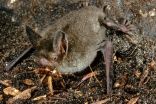(Press-News.org) Sydney, Australia - Fossilised remains of a new bat species, which lived 16 million years ago, walked on four limbs and was three times larger than today's average bat, have been discovered in New Zealand.
The fossils were found near Central Otago on South Island, in sediment left over from a vast prehistoric body of water known as Lake Manuherikia, which was part of warmer subtropical rainforest during the early Miocene era, between 16 and 19-million-years-ago.
The new species, Mystacina miocenalis, was described today in the journal PLOS ONE, and is related to another bat, Mystacina tuberculata, which still lives in New Zealand's old growth forests.
"Our discovery shows for the first time that Mystacina bats have been present in New Zealand for upwards of 16 million years, residing in habitats with very similar plant life and food sources," says lead author and vertebrate palaeontologist, Associate Professor Suzanne Hand from the University of New South Wales (UNSW) in Australia.
New Zealand's only native terrestrial mammals are three species of bat, including two belonging to the Mystacina genus - one of which was last sighted in the 1960s. They are known as burrowing bats because they forage on the ground under leaf-litter and snow, as well as in the air, scuttling on their wrists and backward-facing feet, while keeping their wings tightly furled.
These bats were believed to have an ancient history in New Zealand, but until now, the oldest fossil of a Mystacina bat in New Zealand was from a cave in South Island, dating to 17,500 years ago. This latest discovery forces a rethink of when these peculiar, walking bats first crossed the ditch, arriving from what is present-day Australia.
"This helps us understand the capacity of bats to establish populations on islands and the climatic conditions required for this to happen," says Associate Professor Hand.
"Bats are important pollinators and seed dispersers that keep forests healthy. Understanding the connectivity between the bat faunas of different landmasses is important for evaluating biosecurity threats and conservation priorities for fragile island ecosystems."
The new species has similar teeth to its contemporary relative, suggesting a broad diet that included nectar, pollen and fruit, as well as insects and spiders. Limb bones found in the deposit also showed similar structures specialised for walking.
Where they differ is body size: at an estimated 40 grams, the fossil bat is roughly three times heavier than its living cousin, and the average weight of more than 900 living bat species.
"The size of bats is physically constrained by the demands of flight and echolocation, as you need to be small, quick and accurate to chase insects in the dark," explains Associate Professor Hand. "The unusually large size of this bat suggests it was doing less in-flight hunting and was taking heavier prey from the ground, and larger fruit than even its living cousin."
The team also found a diverse array of plant, animal and insect fossils at the site, which shows that the 16-million-year-old subtropical ecosystem bore resemblance to the more temperate one that exists today.
"Remarkably, the Miocene ecosystems associated with the fossil bat contain the kinds of trees used today by Mystacina for its colonial roosts," says Associate Professor Hand. "Most of its food plants are also represented, as are terrestrial arthropods including a variety of beetles, ants and spiders, which these bats continue to hunt on the ground."
The Lake Manuherikia site has been a treasure trove for palaeontologists over the years, producing New Zealand's oldest frogs, lizards and land birds, as well as its only crocodiles and terrestrial turtles.
INFORMATION:
Associate Professor Hand led the research along with Associate Professor Daphne Lee from the University of Otago, and Dr Trevor Worthy from Flinders University in South Australia.
Media Contact: Myles Gough, UNSW Media Office, +61 4 9116 2717, myles.gough@gmail.com
Associate Professor Suzanne Hand, s.hand@unsw.edu.au
In a finding that furthers the understanding of human immunodeficiency virus (HIV), researchers from Children's Hospital Los Angeles discovered two locations where a single difference in HIV's genetic code altered the way the virus infected the cell, thereby influencing the progression of the disease.
The results of this study will be published in PLOS ONE on June 17.
HIV targets specific white blood cells, called CD4+ T-cells, which play an important role in organizing the immune response to bacteria and viruses. By using two different receptors, CCR5 (R5) or CXCR4 ...
A new study led from Karolinska Institutet in Sweden links male infertility to autoimmune prostatic inflammation. The findings are published in the journal Science Translational Medicine.
Involuntary childlessness is common, and in half of all cases attributable to infertility in the man. Although male infertility has many possible causes, it often remains unexplained.
In the present study, the researchers have discovered a reason for reduced fertility in people with autoimmune polyendocrine syndrome type 1 (APS1), which increases the risk of developing autoimmune ...
BOSTON -- A new drug screening technology developed at the Harvard T.H. Chan School of Public Health has identified a new potential anti-diabetes compound--and a powerful way to quickly test whether other molecules can have a positive effect on a critical molecular pathway believed to be central to diseases ranging from diabetes to retinitis pigmentosa, cystic fibrosis, Huntington's disease, and Alzheimer's.
The study appears in the June 17, 2015 issue of Science Translational Medicine.
The compound, which the authors have called azoramide*, works by focusing on an ...
Scientists at the Charité - University Medicine Berlin, Department for General, Visceral and Transplantation Surgery, led by Dr. Georg Damm (and Prof. Dr. Daniel Seehofer) have established a protocol for an uncomplicated isolation of primary human hepatocytes (PHH), Kupffer cells (KC), liver endothelial cells (LEC), and human Stellate cells (HSC) from human donor tissue. Liver cells were isolated from the tissue using a two-step EDTA/collagenase perfusion technique, followed by a separation of PHH and different non-parenchymal cell (NPC) fractions through Percoll density ...
This Week From AGU: Gender parity in the geosciences, Tibetan Plateau formation
From eos.org: Working Toward Gender Parity in the Geosciences
How are women represented in the geosciences? The author of a new AGU book, Women in the Geosciences: Practical, Positive Practices Toward Parity, answers some questions.
From AGU's journals: Dynamics of the Earth's Surface in the Eastern Tibetan Plateau
The evolution of mountains is written in the histories of the rocks that make up their ranges. Scientists have long used areas where rivers cut deep incisions in rock ...
Scientists at The University of Manchester have made an important discovery that forms the basis for the development of new applications in biofuels and the sustainable manufacturing of chemicals.
Based at the Manchester Institute of Biotechnology (MIB), researchers have identified the exact mechanism and structure of two key enzymes isolated from yeast moulds that together provide a new, cleaner route to the production of hydrocarbons.
Published in Nature, the research offers the possibility of replacing the need for oil in current industrial processes with a greener ...
The moon is engulfed in a permanent but lopsided dust cloud that increases in density when annual events like the Geminids spew shooting stars, according to a new study led by University of Colorado Boulder.
The cloud is made up primarily of tiny dust grains kicked up from the moon's surface by the impact of high-speed, interplanetary dust particles, said CU-Boulder physics Professor Mihaly Horanyi. A single dust particle from a comet striking the moon's surface lofts thousands of smaller dust specks into the airless environment, and the lunar cloud is maintained by ...
In a remarkable demonstration of the curative power of memory, published in Nature, scientists have established that artificial reactivation of memories stored during a positive experience can suppress the effects of stress-induced depression. The research, conducted by scientists at the RIKEN-MIT Center for Neural Circuit Genetics, a joint collaboration of RIKEN Brain Science Institute in Japan and MIT, shows how positive and negative memories interact in mood disorders, and provides a specific brain circuit for future clinical interventions.
The research, conducted ...
BUFFALO, N.Y. - Sit down with a friend in a quiet restaurant and begin talking, just before the dinner crowd's arrival. Business is slow at first, but picks up quickly, just like the sound level. Music plays, glasses clink, servers discuss specials. Discussions are everywhere, colliding and competing with the other noises.
All of these sounds are hitting the eardrum at the same time, yet the initial conversation that began amidst surrounding silence continues easily because of a process that allows humans to isolate, identify and prioritize overlapping sounds.
Sometimes ...
BLOOMINGTON, Ind. -- An international team of researchers from Indiana University and Switzerland is using data mapping methods created to track the spread of information on social networks to trace its dissemination across a surprisingly different system: the human brain.
The research team from the IU Bloomington Department of Psychological and Brain Sciences and School of Informatics and Computing found that applying social network models to the brain reveals specific connections and nodes that may be responsible for higher forms of cognition.
The results are reported ...



